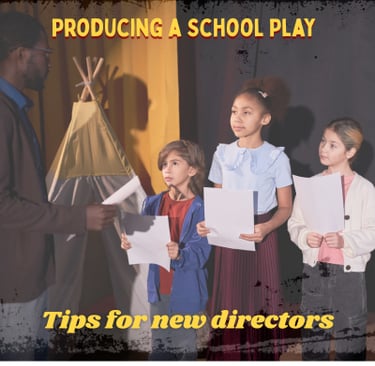How to Put On a Play (For New Drama Teachers and Non-Theater Teachers Alike)
New to directing school plays? This step-by-step guide for how to put on a school play is for drama and non-theater teachers covers everything from choosing a script to performance night. Get tips on budgeting, auditions, rehearsals, and more!
Katie Zakkak
7/22/20252 min read



This guide is especially for newer drama teachers or educators with little to no theater background who are tasked with putting on a class play or launching an afterschool theater program. I won’t sugarcoat it—putting on a play is a big undertaking. But with the right mindset and preparation, it’s absolutely doable, and incredibly rewarding!
This post will walk you through the basic steps and key decisions involved in staging a play from scratch.
Step 1: Identify Your Goals
Start by clarifying why you're putting on this play.
Is it part of your curriculum? (e.g., a play tied to your history or science unit?)
Or is it more of an enrichment activity after school?
Your goal shapes the type of play you choose, the level of commitment needed, and how much production value is expected.
Step 2: Budget, Licensing & Permissions
Ask:
Do you have a budget from your school?
Do you need to get permission before starting?
Will families contribute with costumes or set pieces?
You don’t need a huge budget to do a play, but you do need to know how much you have before choosing your script.
Script & Licensing Sources:
Small budget & curricular tie-in?
Try Bad Wolf Press — Their musical plays align with subjects like science and history and often include digital scripts and music for ~$80.Larger, well-known shows?
Check out MTI (Musical Theatre International) or Concord Theatricals, which offer junior/kids editions of titles like Shrek Jr., Madagascar, or The Wizard of Oz (all around 60 minutes).Looking for flexibility?
Try Pioneer Drama, which offers customizable shows in a variety of lengths, cast sizes, and styles.
Tip:
Once you pick your show:
Create an account with the licensing company
Apply for the rights
Clarify: Are you using digital scripts or printed copies? Do they need to be returned?
Step 3: Auditions and Rehearsals
Auditions
Make this fit your structure.
In-class, small-scale play?
Teach everyone the same short song or scene. Let students write down their top character choices.After-school or drama class?
Give students a chance to prepare a monologue or song in advance. This helps showcase personality and preparation.
Tip: Clearly communicate audition expectations with families beforehand!
Rehearsals
Before starting rehearsals:
Read the script closely.
Estimate time needed for music, choreography, blocking, and dialogue.
Build your schedule backward from performance week.
Suggested Rehearsal Sequence:
Read-Through
First full group meeting to read and hear the show together.Music Rehearsals
Learn songs before adding movement.Blocking & Choreography
Schedule around group availability—don't worry about teaching in script order.Run-Throughs
Practice scenes in chunks; work toward full runs.Tech Rehearsal
Practice with lights, sound, and props—just like performance day.Dress Rehearsals
Try to do at least two. First one may reveal problems (wardrobe malfunctions, etc.), second one is to fix and polish.
Step 4: Marketing the Show
Low-key class play?
Use your class newsletter or school emails to promote.Bigger production?
Create flyers, school announcements, and ask the school to share posts on social media. Build buzz!
Step 5: The Performance
You made it! Now it’s time for your students to shine. Trust your process, support your cast, and enjoy the results of your hard work.
If you'd like some extra support, check out my Audition and Rehearsal Resources Bundle on TPT!
Break a leg!
You’ve got this — and your students will never forget this experience.
📎 Need help getting started?
Download my Free Drama Teacher Toolkit, filled with goal-setting pages, warm-ups, and a full production checklist to make your first (or fifth!) show a success.
